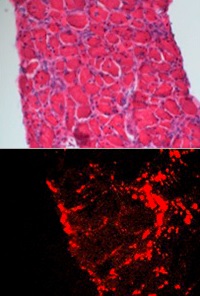 |
| Diaphragm muscle with muscular dystrophy (top) and red fluorescent nanoparticles in the diaphragm (bottom)--Courtesy of FASEB Journal |
Patients with muscular dystrophy suffer from impairment of the gene that produces dystrophin, which is a protein that maintains muscle cells' performance. A team of researchers from the Washington University School of Medicine in St. Louis has now found that another factor might also play a role in the weakened muscles: the cells aren't properly recycling their waste.
And they have a way to fight it.
Cells that don't properly perform this process of autophagy--essentially the cell's garbage disposal system--can become clogged with their own waste. So the researchers have brought nanoparticles into the picture to deliver an immunosuppressive drug that has been shown to improve the cells' ability to do so.
The nanoparticle is a perfluorocarbon core that was originally designed as a blood substitute, according to the university, and the team coated the surface of the vehicle with the immunosuppressive rapamycin, an anti-inflammatory that has shown recently to activate autophagy. Because these nanoparticles accumulate in areas of inflammation, they are efficiently targeted toward the affected muscle cells.
"Some investigators are looking for ways to replace dystrophin," author Conrad Weihl said in a statement. "But here we are focusing on the defect in autophagy. What is exciting about our approach is that there are existing drugs that activate autophagy. And by repackaging the drug on nanoparticles, we can target it specifically to muscles and correct the defect in the cells' ability to recycle waste."
Led by senior authors Kristin Bibee and Samual Wickline, the team tested the treatment on mice with Duchenne muscular dystrophy, which is the most severe inherited form of the disease. The team treated both skeletal muscle and heart muscle, the latter being a major cause of death for people with Duchenne. In the animal tests, the mice showed a 30% improved grip strength and significant increase in blood volume pumped by the heart.
In comparison to other treatments, the nanoparticles "induce(d) a reproducible increase in both skeletal muscle strength and cardiac contractile performance that is not achievable with conventional oral rapamycin, even in pharmacological doses," according to the abstract as published in the Journal of the Federation of American Societies for Experimental Biology (FASEB).
"We showed that oral doses of rapamycin, even at 10 times the dose we used in the nanoparticles, were ineffective," Wiehl said. "This is important because rapamycin suppresses the immune system, and directly targeting it to muscle in smaller doses would reduce unwanted side effects."
- here's the WU news
- and the FASEB abstract